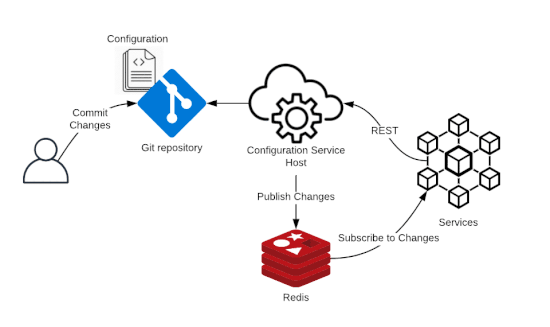| Package | Latest Release |
|---|---|
| ConfigurationService.Hosting | |
| ConfigurationService.Client |
Configuration Service is a distributed configuration service for .NET. Configuration for fleets of applications, services, and containerized micro-services can be updated immediately without the need to redeploy or restart. Configuration Service uses a client/server pub/sub architecture to notify subscribed clients of configuration changes as they happen. Configuration can be injected using the standard options pattern with IOptions, IOptionsMonitor or IOptionsSnapshot.
Configuration Service currently supports hosting configuration with git, file system or Vault backends and supports publishing changes with Redis, NATS or RabbitMQ publish/subscribe. File types supported are .json, .yaml, .xml and .ini.
- RESTful HTTP based API for external configuration.
- Server easily integrates into an ASP.NET application.
- Client easily integrates into any .NET Standard 2.0 application using the standard
ConfigurationBuilderpattern. - Client encapsulates real-time configuration updates.
- Support for git, file system and Vault backend storage.
- Support for pub/sub with Redis, NATS and RabbitMQ.
- Support for .json, .yaml, .xml and .ini configuration files.
- Inject configuration with
IOptionsMonitororIOptionsSnapshotto access configuration changes.
The easiest way to install Configuration Service is with NuGet.
In Visual Studio's Package Manager Console, enter the following command:
Server:
Install-Package ConfigurationService.Hosting
Client:
Install-Package ConfigurationService.Client
The Configuration Service host middleware can be added to the service collection of an existing ASP.NET application. The following example configures a git storage provider with a Redis publisher.
builder.Services.AddConfigurationService()
.AddGitProvider(c =>
{
c.RepositoryUrl = "https://github.com/jamespratt/configuration-test.git";
c.LocalPath = "C:/local-repo";
})
.AddRedisPublisher("localhost:6379");In Startup.Configure, call MapConfigurationService on the endpoint builder. The default pattern is "/configuration".
app.UseEndpoints(endpoints =>
{
endpoints.MapConfigurationService();
});The configured host will expose two API endpoints:
configuration/- Lists all files at the configured provider.configuration/{filename}- Retrieves the contents of the specified file.
| Property | Description |
|---|---|
| RepositoryUrl | URI for the remote repository. |
| Username | Username for authentication. |
| Password | Password for authentication. |
| Branch | The name of the branch to checkout. When unspecified the remote's default branch will be used instead. |
| LocalPath | Local path to clone into. |
| SearchPattern | The search string to use as a filter against the names of files. Defaults to no filter (*). |
| PollingInterval | The interval to check for remote changes. Defaults to 60 seconds. |
services.AddConfigurationService()
.AddGitProvider(c =>
{
c.RepositoryUrl = "https://example.com/my-repo/my-repo.git";
c.Username = "username";
c.Password = "password";
c.Branch = "main";
c.LocalPath = "C:/config";
c.SearchPattern = ".*json";
c.PollingInterval = TimeSpan.FromSeconds(60);
}
...| Property | Description |
|---|---|
| Path | Path to the configuration files. |
| SearchPattern | The search string to use as a filter against the names of files. Defaults to no filter (*). |
| IncludeSubdirectories | Includes the current directory and all its subdirectories. Defaults to false. |
| Username | Username for authentication. |
| Password | Password for authentication. |
| Domain | Domain for authentication. |
services.AddConfigurationService()
.AddFileSystemProvider(c =>
{
c.Path = "C:/config";
c.SearchPattern = "*.json";
c.IncludeSubdirectories = true;
})
...| Property | Description |
|---|---|
| ServerUri | The Vault Server Uri with port. |
| Path | The path where the kv secrets engine is enabled. |
| AuthMethodInfo | The auth method to be used to acquire a Vault token. |
| PollingInterval | The interval to check for for remote changes. Defaults to 60 seconds. |
services.AddConfigurationService()
.AddVaultProvider(c =>
{
c.ServerUri = "http://localhost:8200/";
c.Path = "secret/";
c.AuthMethodInfo = new TokenAuthMethodInfo("myToken");
})
...Custom implementations of storage providers and publishers can be added by implementing the IProvider and IPublisher interfaces and calling the appropriate extension methods on AddConfigurationService:
services.AddConfigurationService()
.AddProvider(new CustomStorageProvider())
.AddPublisher(new CustomPublisher());The Configuration Service client can be configured by adding AddRemoteConfiguration to the standard configuration builder. In the following example, remote json configuration is added and a Redis endpoint is specified for configuration change subscription. Local configuration can be read for settings for the remote source by using multiple instances of configuration builder.
var loggerFactory = LoggerFactory.Create(builder =>
{
builder.AddConsole();
});
IConfiguration configuration = new ConfigurationBuilder()
.AddJsonFile("appsettings.json", optional: false, reloadOnChange: true)
.Build();
configuration = new ConfigurationBuilder()
.AddConfiguration(configuration)
.AddRemoteConfiguration(o =>
{
o.ServiceUri = "http://localhost:5000/configuration/";
o.AddConfiguration(c =>
{
c.ConfigurationName = "test.json";
c.ReloadOnChange = true;
c.Optional = false;
});
o.AddConfiguration(c =>
{
c.ConfigurationName = "test.yaml";
c.ReloadOnChange = true;
c.Optional = false;
c.Parser = new YamlConfigurationFileParser();
});
o.AddRedisSubscriber("localhost:6379");
o.AddLoggerFactory(loggerFactory);
})
.Build();| Property | Description |
|---|---|
| ServiceUri | Configuration service endpoint. |
| HttpMessageHandler | The optional HttpMessageHandler for the HttpClient. |
| RequestTimeout | The timeout for the HttpClient request to the configuration server. Defaults to 60 seconds. |
| LoggerFactory | The type used to configure the logging system and create instances of ILogger. Defaults to NullLoggerFactory. |
| AddConfiguration | Adds an individual configuration file. |
| ConfigurationName | Path or name of the configuration file relative to the configuration provider. This value should match the value specified in the list returned by the configuration/ endpoint. |
| Optional | Determines if loading the file is optional. |
| ReloadOnChange | Determines whether the source will be loaded if the underlying file changes. |
| Parser | The type used to parse the remote configuration file. The client will attempt to resolve this from the file extension of ConfigurationName if not specified.Supported Types:
|
| AddRedisSubscriber | Adds Redis as the configuration subscriber. |
| AddNatsSubscriber | Adds NATS as the configuration subscriber. |
| AddRabbitMqSubscriber | Adds RabbitMQ as the configuration subscriber. |
| AddSubscriber | Adds a custom configuration subscriber the implements ISubscriber. |
| AddLoggerFactory | Adds the type used to configure the logging system and create instances of ILogger. |
Samples of both host and client implementations can be viewed at Samples.
